Abstract
The article describes the results of developing and testing interactive multimedia teaching materials to support reading of the most widely read French book in the world - The Little Prince (fr. “Le Petit Prince”), a philosophical tale by Antoine de Saint-Exupery.The paper views an electronic educational resource (EER) as a hybrid training course, catalyzing college students’ external motivation in the process of foreign language teaching / learning. The paper substantiates the didactic potential of WEB - technologies in FLT based on the principle of developmental education, which presumes students’ learning autonomy, independence and creativity. Web-technologies described in the article are used for creating interactive multimedia training materials on the basis iSpring programs for developing training courses for contact and distance learning. The effectiveness of electronic educational resources is assessed on the basis of a comprehensive evaluation system with regard to the following criteria: the students’ subjective satisfaction with the course program, practical skills the students acquire in the process of developing the resource, the time required to master the materials developed. The article proves that the training platform contributes to intensifying FL teaching / learning process and activates the students’ internal and external motivation. The paper argues that networking experience is in demand not only because it is a model to follow, but also an indicator, or mirror that allows to assess one’s level of professional competency, and come up with some new ideas for future projects.
Keywords: Distance learningiSpring programelectronic educational resourceinteractive multimedia materialslanguage teachinglearning practices
Introduction
Modern education, including its FL component, poses new challenges, which are reflected in the current-generation Federal State Educational Standard of Higher Education. The dominant idea of the standard is to form and develop universal and professional competences and professional culture of a specialist of the future ready to address challenges and problems using one’s acquired knowledge, abilities and skills, professional values and practical experience. In this regard, it is logical to ask the community of educational researchers a question about the “optimistic projection” of the development of language teaching / learning practices (Tareva, 2015), including the use of WEB-technologies that expand the range of teaching strategies and create conditions for mastering new organizational modes of FL teaching.
Problem Statement
The growing interest to the problem of intensive development and introduction of new teaching technologies is a vivid manifestation of globalization processes taking place in the world. Interactive language courses in the framework of a blended educational model extend a teacher’s creativity and allow the breeding of a successful, independent, and self-confident student.
Research Questions
The modern format of the functioning of humanitarian knowledge which can change the world presupposes its readiness to be competitive, i.e. capable of creating such an intellectual product which due to the emergence of new humanitarian technologies will be in demand in the domestic market. In such conditions, the question of using specialized educational technologies, which combine modern didactic and methodological recommendations, becomes vital.
Purpose of the Study
The goal of the research under review may be described as an attempt to present a technology of creating electronic teaching materials by liberal arts undergraduate students of teacher training institutions. The prime purpose of this paper is to consider the specifics of generating electronic educational resources to be used in face-to-face and distance FL learning. Goal-oriented interaction of educational process is one of the aspects conducive to enhancing the quality of FL teaching. As an activity involving sharing of resources, networking makes it possible to develop and offer innovative educational content models to the community of educators. Educational practices are perfected through the use of modern computer technologies, which encourage FL teaching professionals to generate and use interactive multimedia materials in the framework of the blended teaching / learning model. But this provision has to be substantiated by the action research that will prove the effectiveness of the teaching model on the basis of a specific training platform.
Research Methods
The material and tasks of the research have determined the choice of methods and techniques for analysing the benefits of a teaching / learning platform. In particular, what comes to the fore is the use of project technology aimed at shaping student’s information and communicative competence. The issue which acquires specific acuteness is education-related uses of IT based on specialized electronic resources that meet modern pedagogical and methodological requirements (Solomon & Schrum 2014). An important factor facilitating the dynamic implementation of modern web-based tools in FL teaching / learning is their wide range: microblogging and wiki sites, all seen as tools for creating a virtual training class, audio resources and podcasts (VoiceThread, Audacity, Audiopal, Chirbit, Gabcast), etc. (Zheltukhina, Vikulova, Serebrennikova, Gerasimova, & Borbotko, 2016).
An important role in this context is played by electronic educational resources, which open up fresh opportunities for teachers to create new forms of education. At the same time, educational practices are being improved thanks to the use of modern computer technologies, which encourages FL teaching professionals to make the most of interactive multimedia materials and embrace a blended learning model (Vikulova, Makarova, & Gerasimova, 2018).
Network interaction facilitates diffusion of innovative developments and promotes dialogue between educational institutions. So, Stage 1 of such communications is firmly established in educational activities: seminars, round tables, conferences, etc. Stage 2 includes arrangements to support interaction and dissemination of best practices based on Internet technologies. In particular, the electronic resource was approved at the international conference "The Magic of Innovation: Integrated Trends in Linguistics and Foreign Language Teaching" held at MGIMO-University on 22-23 March 2019. Created using the iSpring Suite-9 program, the electronic learning resource to support communication-oriented reading was presented at the section "Information Technologies: New Horizons in Foreign Language Teaching" in a format that can be played back on traditional multimedia equipment in a classroom setting, and also in a format that allows publishing it in distance learning systems.
Findings
Among the principal requirements for designing the proposed course is availability to the learner of direct navigation from one structural unit to another logically associated with the first one, as well as the ability to move from one section of the electronic resource to another.
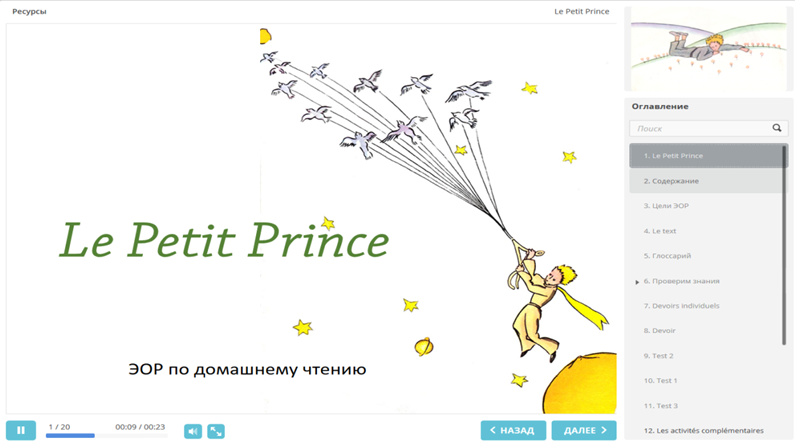
The resource under review was developed to support French language classes based on
The main instructional property of the EER is its multimedia potential. Multimedia tools impart
interactivity to mobile and computer devices: video, full-color images, the ability to speak and understand certain phrases, listen to music, etc. All this enhances motivation for learning. Research on activity-competence approach to teaching / learning aids (Tareva & Kazantseva, 2011), has proved that the use of various kinds of support (verbal, graphic, pictorial, sound) facilitates semantic perception, hones the learners’ anticipation mechanism, and enhances learning motivation.
The chapter-by-chapter method of working with the text correlates with the theory of teaching foreign languages, according to which any activity (including speaking) passes through a number of phases: motivational-incentive, analytical-synthetic, actual performance, and evaluation-correction.
The purposes of using the electronic resource are:
engage students in interaction and cooperation;
support comprehension of a complex text using such props as audio, video and graphic materials;
develop perception and comprehension reading skills of authentic fiction in a foreign language;
develop students’ linguаcultural competence.
A distinctive feature of the proposed electronic resource is the comprehensive nature of the educational material and the focus on streamlining of educational activities and on creative learning of the material by combining linguistic and cultural content. In so doing, attention is focused on the idea that by learning the other than one’s own language and culture, the reader is enriched not only with language knowledge, but also expands his/her individual worldview.
The following sequence of activities is utilized in each section of the EER.
In a methodologically processed text, italics are used to highlight the words and phrases which are most difficult to understand; they are translated or explained after the text using synonyms or definitions. Receptive activities (“read and ...”, “listen and ...”) help master the vocabulary by translating individual words and in some cases visualizing them. Unfamiliar vocabulary, italicized in the text, is alphabetically presented in the consolidated glossary, which makes it easy to find the right word when reading the text. In some cases, difficult words may be visualized.
The purpose of post-reading activities is to activate grammar and vocabulary, test and enhance comprehension of the text using various types of testing techniques, thereby contributing to further enhancement of speaking and writing, as well as creative and analytical skills.
The rubric La synthèse de la lecture consists of three parts, suggesting a summary analysis of three or more chapters of the book. It contains additional activities aimed at improving communicative skills, discussing and interpreting the writer’s message and implicit cultural information.
The rubric
The next section tests the knowledge of the lexical units used in the presented interactivity (Fig. 3).
The proposed tests and communicative tasks determine not only the reading strategy, but also the development of personal attitude to the texts.
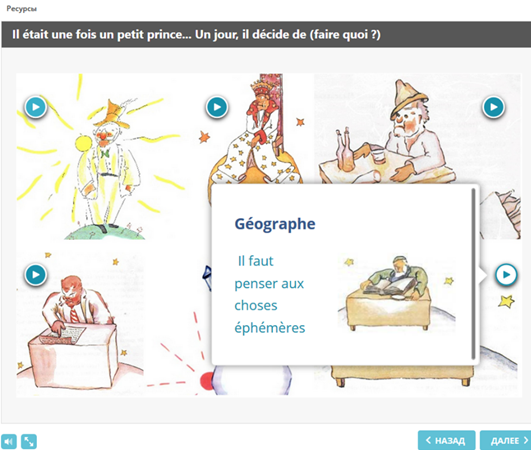
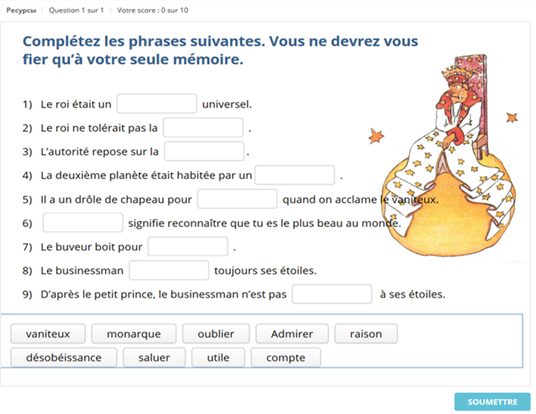
The fate of a literary art work is important, in that it is shaped by both the reader’s or viewers’ reception and the author’s literary reputation (Vikulova, Gerasimova, Makarova, & Esinа, 2016). In particular, the electronic resource offers an adaptation of the text in the French-language musical. The literary source was not originally adapted for the stage, but rewritten into the text of a dramatization, thereby beginning a life of its own, separated from the original text. Thus, the adaptation of a fairy tale for the music scene in a French-speaking musical is reflected in the electronic resource, in particular, presenting the history of the performance and offering excerpts of the musical version. The existence of a literary text in a different cultural environment makes it possible to talk about the parallel existence of two texts and their interaction - the author's text and the adapted text, the latter in accordance with the new format of its existence. The following task from the EER is addressed to a different visual interpretation of the text: “Is it possible to assert that in such art forms there is a search for and choices of those value dominants and moral supports that will help correlate the field of world cultural meanings and the perception of a modern child? Justify your point of view in the form of a presentation”.
It is important for students to understand how a literary work can turn into a secondary art object when the visual interpretation of a text is embodied, for example, in urban sculpture and architecture. In this case, book culture is combined with urbanism, a practice whereby literature is 'embedded' in the urban environment, creating new opportunities to visualize the literary text. The task below is aimed at understanding the peculiarities of the dialogue between the author and his readers: “Can you agree or disagree with the assertion that the presence of a literary character in the urban environment forms a mosaic of the urban dweller's spatial experience, reflecting a synthesis of literature with plastic art? Do these art objects enhance the prestige of reading a book? Justify your point of view in a presentation format”.
Students are invited to perform a creative assignment by referring to the French-language biography of the writer. The file with the biography is attached to the
New information content is provided by interesting and little-known facts from the life of the writer, proposed in the format of interactivity (Fig.4). The assignment assumes again that one needs to (i) revisit the biography with which the students familiarized themselves before reading the book, and (ii) present a personal view as to the fate of the man as writer and pilot.
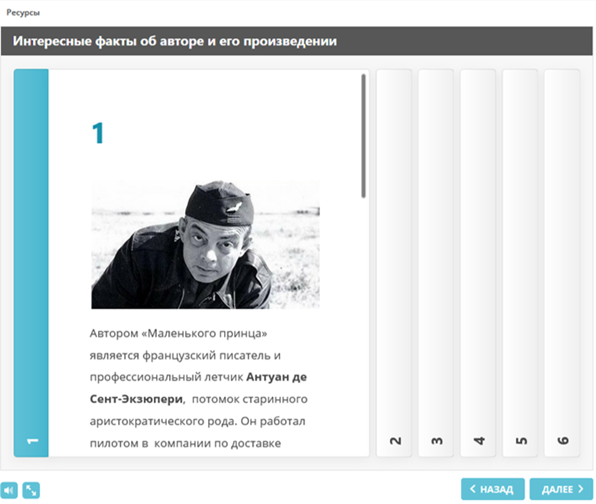
An interesting section of the resource is a selection of famous quotations from
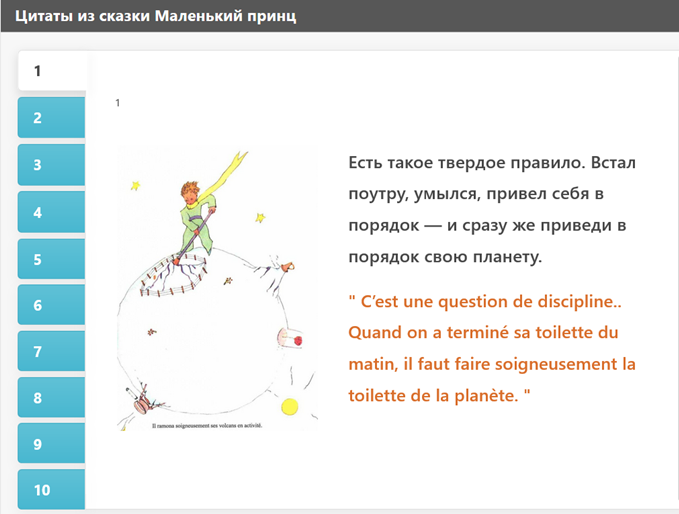
Conclusion
Modern web technologies in FLT expand the range of speech activities facilitating the development of new organizational modes and teaching methods. The study of the possibilities offered by the use of an interactive language course in conjunction with a blended learning model has demonstrated that the electronic resource expands the teachers’ creative horizons and makes it possible to train a successful, independent, and autonomous learner.
Thanks to the use of the EER program, the possibilities of online open-source tasks (creative tasks) are most fully realized. At the same time, the blended learning model is equally applicable to both the traditional and intensive FL courses.
Working with an electronic educational resource is aimed at revisiting and rethinking the goals and objectives of today’s FL teachers who carry out their professional activity in the dynamic and highly changeable world today. Modern technologies are considered an active agent for enhancing the quality of the educational process and a vital pre-condition for developing modern teacher professional competency.
Generating such materials by students makes it possible to delve deeply into selected topics, since their interest in specific topics of educational materials should be taken into account. To date, more than 50 interactive multimedia materials have been developed by the students of the Institute of Foreign Languages of the Moscow City University, which we intend to put online to ensure wide access of anyone interested in using teaching / learning FLT technologies. In determining the effectiveness of electronic educational resources, we proceed from a comprehensive assessment based on the following criteria: the students' subjective satisfaction with the course, practical skills acquired by the students, the time required to create a resource and share their teaching tips with other classroom teachers.
All types of training materials (online courses, video lectures, training devices, tests, polls, interactivities) used to build a particular course are concentrated in one iSpring Suite program. A significant feature is the add-in over Microsoft Office (Power Point), which is a time-saver, allowing the consumer not to waste time getting used to the interface. Optimization and compatibility with various LMS-systems (Moodle and Web Soft Web tutor) is possible, as packaging is supported in all known SCORM- and NON-SCORM-packages.
In conclusion, we’d like to stress that networking experience is in demand not only because it’s a model to follow, but also an indicator, or mirror that allows to assess one’s level of professional competency, and come up with some new ideas for future projects.
References
- Solomon, G., & Schrum L. (2014). Web 2.0: How-To for Educators (2nd ed.). Washington, DC: International Society for Technology in Education.
- Tareva, E. G. (2011). Dynamics of value meanings of linguodidactics. Linguistics and axiology: ethno-semiometry of value meanings. Moscow: THESAURUS.
- Tareva, E. G. (2015). Development of linguistic practices: an optimistic projection. Vestnik Moskovskogo gorodskogo pedagogicheskogo universiteta, 2(18), 75-85.
- Tareva, E. G., & Kazantseva, E. M. (2011). The activity-competence approach to the creation of textbooks for training bachelors. Vestnik Moskovskogo gorodskogo pedagogicheskogo universiteta, 2(8), 65-77.
- Vikulova, L. G., Gerasimova, S. A., Makarova, I. V., & Esinа, A. V. (2016). Philosophical Fairy Tale The Little Prince as a Cultural Phenomenon: On the Question of Literary Reputation, Readership and Viewership Reception. Crede Experto, 3(10), 1-13.
- Vikulova, L. G., Makarova, I. V., & Gerasimova, S. A. (2018). IG. Espacios, 39(20), 5.
- Zheltukhina, M. R., Vikulova, L. G., Serebrennikova, E. F., Gerasimova, S. A., & Borbotko, L. A. (2016). Identity as an Element of Humanity: Axiological aspect. International Journal of Environmental and Science Education, 11(17), 10413-10422.
Copyright information

This work is licensed under a Creative Commons Attribution-NonCommercial-NoDerivatives 4.0 International License.
About this article
Publication Date
23 January 2020
Article Doi
eBook ISBN
978-1-80296-077-8
Publisher
European Publisher
Volume
78
Print ISBN (optional)
-
Edition Number
1st Edition
Pages
1-838
Subjects
Teacher, teacher training, teaching skills, teaching techniques
Cite this article as:
Gerasimova*, S., Makarova, I., Yazykova, N., & Vikulova, L. (2020). "New Technologies In Teaching Foreign Languages: Expertise In Network Interactions". In R. Valeeva (Ed.), Teacher Education- IFTE 2019, vol 78. European Proceedings of Social and Behavioural Sciences (pp. 260-268). European Publisher. https://doi.org/10.15405/epsbs.2020.01.32
